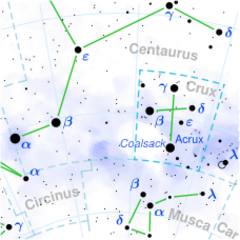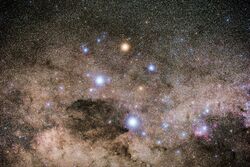Astronomy:Gamma Crucis
| Observation data Equinox J2000.0]] (ICRS) | |
|---|---|
| Constellation | Crux |
| Right ascension | 12h 31m 09.95961s[1] |
| Declination | −57° 06′ 47.5684″[1] |
| Apparent magnitude (V) | +1.64[2] |
| Characteristics | |
| Spectral type | M3.5 III[3] |
| Apparent magnitude (J) | −1.99 |
| U−B color index | +1.78[2] |
| B−V color index | +1.59[2] |
| Variable type | SRV[3] |
| Astrometry | |
| Radial velocity (Rv) | +20.6[4] km/s |
| Proper motion (μ) | RA: +28.23[1] mas/yr Dec.: −265.08[1] mas/yr |
| Parallax (π) | 36.83 ± 0.18[1] mas |
| Distance | 88.6 ± 0.4 ly (27.2 ± 0.1 pc) |
| Absolute magnitude (MV) | −0.52[5] |
| Details | |
| Mass | 1.5 ± 0.3[6] M☉ |
| Radius | 84[7] R☉ |
| Luminosity | 820±80[8] L☉ |
| Temperature | 3,626[9] K |
| Other designations | |
| Database references | |
| SIMBAD | data |
Gamma Crucis (γ Crucis, abbreviated Gamma Cru, γ Cru), also named Gacrux,[10] is the nearest M-Giant star to the Sun.[7] The distance to Gacrux has been determined using parallax measurements made during the Hipparcos mission, which yielded a value of 88.6 light-years (27.2 parsecs) away from the Sun.[1] With an apparent visual magnitude of +1.63,[11] this is the third-brightest star in the southern circumpolar constellation of Crux, the Southern Cross, and one of the brightest stars in the night sky. A line from the two "Pointers", Alpha Centauri through Beta Centauri, leads to within a few degrees of this star.
Nomenclature
γ Crucis (Latinised to Gamma Crucis) is the star's Bayer designation.
Since Gamma Crucis is at roughly −60° declination, it lacks a traditional name. Nonetheless, it was known to the Ancient Greece and Romans, in whose era it was visible north of 40° latitude due to the precession of equinoxes. The astronomer Ptolemy counted it as part of the constellation of Centaurus.[12] The historical name Gacrux is a contraction of the Bayer designation, coined by astronomer Elijah Hinsdale Burritt (1794-1838).[13][14] In 2016, the International Astronomical Union organized a Working Group on Star Names (WGSN)[15] to catalog and standardize proper names for stars. The WGSN's first bulletin of July 2016[16] included a table of the first two batches of names approved by the WGSN; which included Gacrux for this star.
In Chinese, 十字架 (Shí Zì Jià), meaning Cross, refers to an asterism consisting of Gamma Crucis, Alpha Crucis, Beta Crucis and Delta Crucis.[17] Consequently, Gamma Crucis itself is known as 十字架一 (Shí Zì Jià yī, English: the First Star of Cross.).[18]
The people of Aranda and Luritja tribe around Hermannsburg, Central Australia named Iritjinga, "The Eagle-hawk", a quadrangular arrangement comprising this star, Delta Crucis (Palida), Gamma Centauri (Muhilfain) and Delta Centauri (Ma Wei).[19]
Among Portuguese-speaking peoples it is also named Rubídea (or Ruby-like), in reference to its color.
Physical properties
| Period (days) |
Amplitude (magnitude) |
|---|---|
| 12.1 | 0.016 |
| 15.1 | 0.027 |
| 16.5 | 0.016 |
| 54.8 | 0.026 |
| 82.7 | 0.015 |
| 104.9 | 0.016 |
Gacrux has a stellar classification M3.5 III.[3] It has evolved off of the main sequence to become a red giant star, but is most likely on the red giant branch rather than the asymptotic giant branch.[7] Although only 30% more massive than the Sun,[6] at this stage the star has expanded to 84[7] times the Sun's radius. It is radiating roughly 820[8] times the luminosity of the Sun from its expanded outer envelope. With an effective temperature of 3,626 K,[9] the colour of Gamma Crucis is a prominent reddish-orange, well in keeping with its spectral classification. It is a semi-regular variable with multiple periods.[3] (See table at left.)
The atmosphere of this star is enriched with barium, which is usually explained by the transfer of material from a more evolved companion. Typically this companion will subsequently become a white dwarf.[20] However, no such companion has yet been detected. A +6.4 magnitude companion star lies about 2 arcminutes away at a position angle of 128° from the main star, and can be observed with binoculars. But it is only an optical companion,[21] which is about 400 light years distant from Earth.
In culture
Gamma Crucis is represented in the flags of Australia, New Zealand and Papua New Guinea as one of five stars which comprise the Southern Cross. It is also featured in the flag of Brazil , along with 26 other stars, each of which represents a state. Gamma Crucis represents the State of Bahia.[22]
See also
References
- ↑ 1.0 1.1 1.2 1.3 1.4 1.5 van Leeuwen, F. (November 2007), "Validation of the new Hipparcos reduction", Astronomy and Astrophysics 474 (2): 653–664, doi:10.1051/0004-6361:20078357, Bibcode: 2007A&A...474..653V
- ↑ 2.0 2.1 2.2 Ducati, J. R. (2002). "VizieR Online Data Catalog: Catalogue of Stellar Photometry in Johnson's 11-color system". CDS/ADC Collection of Electronic Catalogues 2237: 0. Bibcode: 2002yCat.2237....0D.
- ↑ 3.0 3.1 3.2 3.3 3.4 Tabur, V. et al. (December 2009), "Long-term photometry and periods for 261 nearby pulsating M giants", Monthly Notices of the Royal Astronomical Society 400 (4): 1945–1961, doi:10.1111/j.1365-2966.2009.15588.x, Bibcode: 2009MNRAS.400.1945T
- ↑ Wielen, R. et al. (1999), "Sixth Catalogue of Fundamental Stars (FK6). Part I. Basic fundamental stars with direct solutions", Veröff. Astron. Rechen-Inst. Heidelb (Astronomisches Rechen-Institut Heidelberg) 35 (35): 1, Bibcode: 1999VeARI..35....1W
- ↑ Elgarøy, Øystein; Engvold, Oddbjørn; Lund, Niels (March 1999), "The Wilson-Bappu effect of the MgII K line - dependence on stellar temperature, activity and metallicity", Astronomy and Astrophysics 343: 222–228, Bibcode: 1999A&A...343..222E
- ↑ 6.0 6.1 Murdoch, Kaylene; Clark, M.; Hearnshaw, J. B. (January 1992), "The radial-velocity variability of Gamma Crucis", Monthly Notices of the Royal Astronomical Society 254: 27–29, doi:10.1093/mnras/254.1.27, Bibcode: 1992MNRAS.254...27M
- ↑ 7.0 7.1 7.2 7.3 Ireland, M. J. et al. (May 2004), "Multiwavelength diameters of nearby Miras and semiregular variables", Monthly Notices of the Royal Astronomical Society 350 (1): 365–374, doi:10.1111/j.1365-2966.2004.07651.x, Bibcode: 2004MNRAS.350..365I
- ↑ 8.0 8.1 Ohnaka, K. (January 2014), "High spectral resolution spectroscopy of the SiO fundamental lines in red giants and red supergiants with VLT/VISIR", Astronomy and Astrophysics 561, doi:10.1051/0004-6361/201321581, Bibcode: 2014A&A...561A..47O, https://www.aanda.org/articles/aa/pdf/2014/01/aa21581-13.pdf
- ↑ 9.0 9.1 Cohen, Martin et al. (November 1996), "Spectral Irradiance Calibration in the Infrared. VII.New Composite Spectra, Comparison with Model Atmospheres, and Far-Infrared Extrapolations", Astronomical Journal 112: 2274, doi:10.1086/118180, Bibcode: 1996AJ....112.2274C
- ↑ "IAU Catalog of Star Names". http://www.pas.rochester.edu/~emamajek/WGSN/IAU-CSN.txt. Retrieved 28 July 2016.
- ↑ Johnson, H. L. et al. (1966). "UBVRIJKL photometry of the bright stars". Communications of the Lunar and Planetary Laboratory 4 (99): 99. Bibcode: 1966CoLPL...4...99J.
- ↑ Richard Hinckley Allen, "Star Names: Their Lore and Meaning", Dover Press, 1963.
- ↑ "Gacrux/Gamma Crucis 2?". SolStation.com. http://www.solstation.com/stars2/gacrux2.htm. Retrieved 2011-11-03.
- ↑ Lesikar, Arnold V.. "Gacrux". Dome Of The Sky. Archived from the original on 2011-09-28. https://web.archive.org/web/20110928143206/http://domeofthesky.com/clicks/gacrux.html. Retrieved 2011-11-03.
- ↑ "IAU Working Group on Star Names (WGSN)". https://www.iau.org/science/scientific_bodies/working_groups/280/. Retrieved 22 May 2016.
- ↑ "Bulletin of the IAU Working Group on Star Names, No. 1". http://www.pas.rochester.edu/~emamajek/WGSN/WGSN_bulletin1.pdf. Retrieved 28 July 2016.
- ↑ (in Chinese) 中國星座神話, written by 陳久金. Published by 台灣書房出版有限公司, 2005, ISBN:978-986-7332-25-7.
- ↑ (in Chinese) 香港太空館 - 研究資源 - 亮星中英對照表 , Hong Kong Space Museum. Accessed on line November 23, 2010.
- ↑ p. 8, Explorers of the southern sky: a history of Australian astronomy, Raymond Haynes, Cambridge, Cambridge University Press, 1996.
- ↑ Gomez, A. E.; Luri, X.; Grenier, S. et al. (March 1997), "Absolute magnitudes and kinematics of barium stars", Astronomy and Astrophysics 319: 881–885, Bibcode: 1997A&A...319..881G
- ↑ Kaler, James B., "GACRUX (Gamma Crucis)", Stars (University of Illinois), http://stars.astro.illinois.edu/sow/gacrux.html, retrieved 2012-03-03
- ↑ Astronomy of the Brazilian Flag, FOTW Flags Of The World website, https://flagspot.net/flags/br_astro.html
External links
- "Gacrux/Gamma Crucis 2". SolStation. http://www.solstation.com/stars2/gacrux2.htm. Retrieved 2008-09-10.
Coordinates: ![]() 12h 31m 09.95961s, −57° 06′ 47.5684″
12h 31m 09.95961s, −57° 06′ 47.5684″



